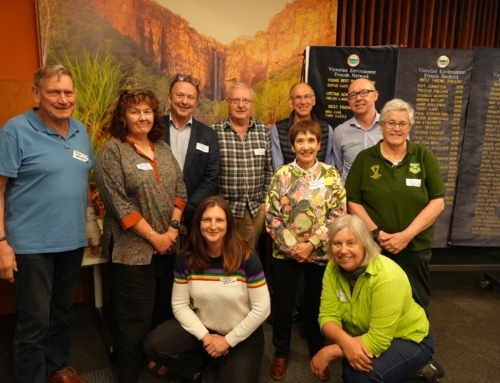
Photo: Orangutans at Tanjung Puting. Photo: Gemma i Jere | Flickr | CC BY-NC-ND 2.0
By Merrin Butler & Paul Strickland, Friends of Mt Worth State Park
On a recent holiday in Indonesia, we had the opportunity to visit three national parks and gain some insight into the many issues faced by park rangers and the volunteers who work alongside them.
All the parks we visited had Friends groups. What we found fascinating was that the issues they faced were so similar to those we deal with in our parks back home. Commitment expressed by governments to protect parks but, at the same time, lack of resources, unwieldy bureaucracies, balancing the demands of tourism with the need for conservation and striving to convince the general population of the long-term economic value of national parks.
The first park we visited was Tanjung Puting in southern Kalimantan, made famous by the Orangutan Research and Conservation Program based at the Camp Leakey research station. While seeing orangutans in the wild is the main drawcard for visitors to the park, it is the preservation of habitat that is the key issue facing park rangers and their associated Friends groups.
Providing employment for local communities is essential to deter poaching of wildlife or overfishing in protected areas. Promoting the enormous tourist potential of these places is often seen as at least part of the solution. But that brings with it problems of balancing conservation with tourist development. The enormous amount of plastic and other rubbish we saw lining rivers and beaches is evidence of that balance not yet being reached.
Threat of palm oil plantations

Day 4: Planting corals on metal frames.
While Tanjung Puting covers an area of over 3000 square kilometres, the numerous threatened species it contains continue to be under pressure from the encroaching palm oil plantations.
Even during our short visit, the effects of this were obvious. A palm oil concession had been granted for the peat rainforest on the other side of the Sekonyer River from Tanjung Puting National Park. It was in the process of being drained, prior to the timber being harvested and the remaining vegetation on its peat base being set on fire. Our guides told us that the land can sustain only two cycles of palm oil production; totalling approximately 50 years. After that, the land is exhausted and laid waste.
The second park we visited was the Thousand Islands Marine National Park, which is a conservation and tourism zone approximately 45km north of Jakarta, an easy boat ride away. We stopped at Pulau Harapan, where we were met by two young park rangers who showed us the Hawksbill turtle conservation program. They then got us involved in planting corals as part of their reef rehabilitation project.
Balancing tourism and conservation was clearly in the forefront of these particular projects. Several of the small islands in the marine conservation zone provide accommodation for visitors from Jakarta, other parts of Indonesia as well as international tourists.
For those who are interested, there are plenty of opportunities to get involved in turtle conservation, coral reef transplantation and mangrove restoration. This is aimed particularly at educating urban Indonesians in the need for protecting their marine environment. It also helps local communities to get actively involved in repairing past damage to their island’s ecosystem.
Many of the houses we passed had trays of mangrove seedlings which they were raising to assist with the mangrove restoration. Some of these households offered homestays for visitors to the area.
Finally, we visited Ujung Kulon National Park on the western tip of Java. This is home to the critically endangered Javan rhinoceros. While seeing one of these rare animals is the drawcard for visitors, again the aim is to protect the habitat for the rhinoceros and the numerous other endangered species of animals, birds and plants that find protection within the park. There is an active Friends group with volunteers from around the world visiting the park to assist with conservation efforts.
More info
- For those who would like to know more about Friends of the National Park Foundation (FNPF) in Indonesia, visit their website at www.fnpf.org.
- To learn more about the Friends of Mt Worth State Park visit their website.





